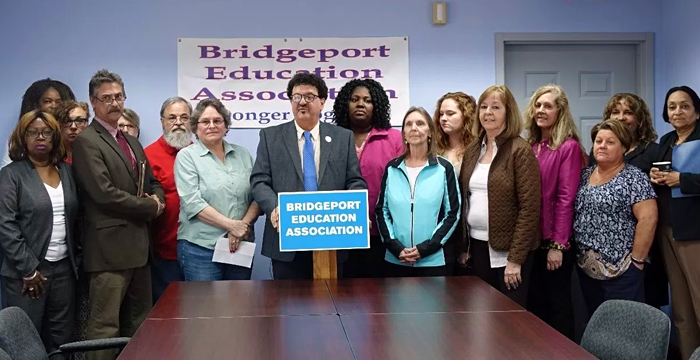Hours before a drastic budget measure affecting the district’s public schools was set to take effect, Bridgeport teachers held a news conference drawing attention to school officials’ refusal to hire substitute teachers for the month of May—a decision that threatens to disrupt learning and jeopardize student safety. Teachers called on administrators to reverse their decision and keep student safety and learning top priorities.

Bridgeport Education Association President Gary Peluchette (at podium) was joined by fellow BEA members at a news conference yesterday. He addressed the district’s refusal to hire substitute teachers for the month of May.
“Without substitutes, we’re not educating our students,” said Bridgeport Education Association President Gary Peluchette. “We’re warehousing them.”
In the case of a classroom teacher’s absence, substitute teachers are able to carry out lessons planned by that teacher, ensuring continuity in the curriculum. Without this safety net, children are crowded into classrooms without enough furniture—sitting on floors and ledges, often with students several grades above or below them—and losing precious learning time.
“Solving a budget crisis at the expense of children is not OK,” said Jettie Tisdale School teacher Mary Krotki.
“Students in classes without substitutes will be divided among other classes in the building,” Peluchette explained, “which interrupts the instructional process for both the students who are being placed in another classroom and the students in the class where they are being placed. This happened back in September. We were shell-shocked and told it would never happen again. But here we are.”

Tiffany Ladson Lang expresses her concerns as both a parent and a teacher.
Tiffany Ladson Lang, a parent and Interdistrict Discovery Magnet School teacher, said she is “deeply concerned” about the impact of this latest decision. “You are compromising students’ education with this decision. Children should be our top priority.”
Ladson Lang wondered what a school day would look like for children whose teacher is absent without a substitute in the classroom. “Will they be moved to an even more crowded classroom? Will they know what to do in an emergency? What are the academic, social, and emotional impacts?” she asked. “I encourage parents to speak up. Better yet, I encourage the Board of Education to provide substitute teachers.”
Special education needs not met
For special education teachers, like Bryant School’s Barbara Edmonds, the absence of substitute teachers carries additional risks.
“My students have individualized education programs, and our classes consist of one teacher, 8 or 9 students, and one or two paraprofessionals to help them succeed,” she said, explaining that smaller class sizes are key to her students’ success. Eliminating substitute teachers, she said, puts an undue burden on her students and colleagues.
“If my self-contained classroom is split up because there is no substitute to cover, it creates a difficult situation, because students are then placed in a full-size, regular classroom with unfamiliar students and teachers who may not know them. They may shut down and not be able to work. There have been situations like this, where parents were called to pick up their child because of the stress of an unfamiliar environment. These unexpected changes can make students anxious, and the disruption in their schedule and routine makes for a very hard day for them.”
Of equal concern is that the students’ IEPs are not being met—a violation of state guidelines.
Divided and conquered
Krotki has had as many as 10 extra students in her class of 24 when no substitutes were provided.
“I didn’t know these additional students’ names,” she recalled. “I didn’t know if anyone was missing or if any child had a medical protocol I needed to follow. There are so many situations you cannot be prepared for.”

Kindergarten teacher Monica Bolbotowski cannot recall a time in her 35-year teaching career where substitute teachers were not hired.
Fellow Tisdale teacher Monica Bolbotowski is concerned about what will happen to her kindergarten students later this month, when she is away attending her daughter’s wedding.
“I’m worried about having my little ones split up. There are 24 of them. I have done double the work preparing for my absence—first, creating lessons plans for a substitute teacher, and now, drawing up ‘split lists’ of which students will go to which teachers, from pre-K through second grade, and making packets for each of my individual students to take them through those two or three days I’m out.”
Bolbotowski has taken no personal or sick days the entire school year, and now she finds herself without a substitute when she needs one.
“I put in for this time off for my daughter’s wedding months ago, and this morning, when I looked at my phone, I saw message after message saying ‘No Substitute Required’ for my time off.” Bolbotowski cannot remember a time in her 35-year teaching career that this has ever happened.
Penny saved, opportunity wasted

“We need to stop shortchanging our students for the purpose of saving a buck,” Antonio Ortiz told reporters at the press conference.
“At the high school level, when substitute teachers are not hired to cover for teacher absences, the burden of coverage falls on our already overtasked and undersupported teachers, many of whom have to give up their prep periods, professional learning communities, and supervisory duties to cover absences,” said Bridgeport Military Academy High School fire science and Spanish teacher Antonio Ortiz, a 41-year veteran.
Teachers in overpopulated classes, with as many as 32 other students, he pointed out, find themselves taking in additional students.
“Increasing the number of manageable students per class diminishes the quality of instruction we are able to provide. The students suffer, and the learning process is compromised. We need to stop shortchanging our students for the purpose of saving a buck.”











